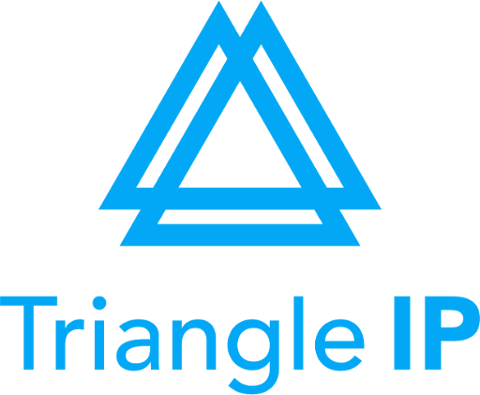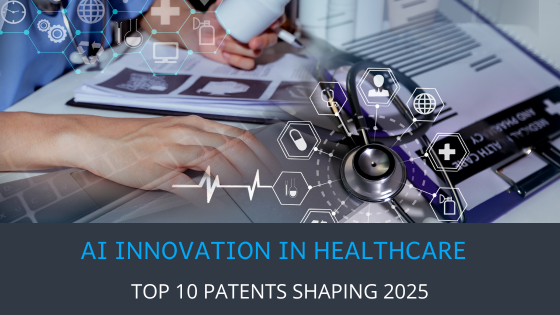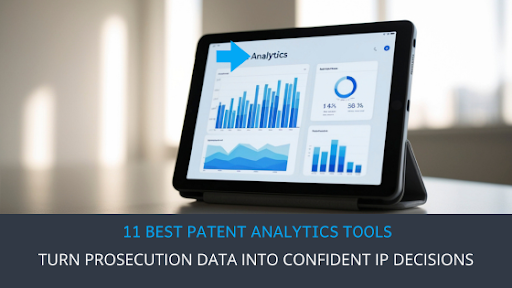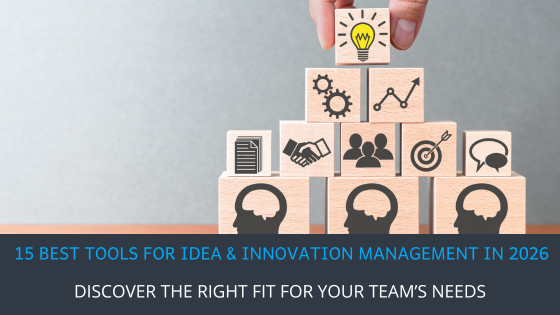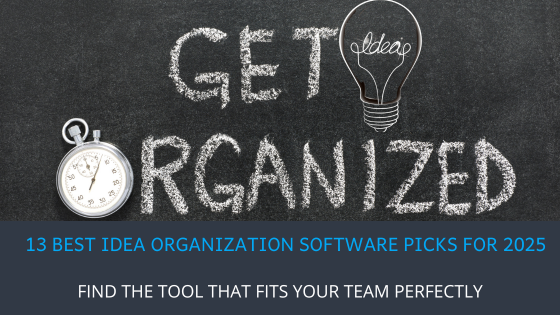| TL;DR: In this article, we dive into 10 examples of AI innovation in healthcare that received patents in 2025. From AI that predicts failed drugs before trials to voice assistants helping with insulin dosing in hospitals, these tools are actively transforming diagnostics, care delivery, and operations. Each innovation is backed by real-world application, funding, and regulatory milestones, giving you a snapshot of where healthcare AI is truly heading. |
Top 10 Patented AI Innovation in Healthcare Transforming 2025
What if we told you the most exciting AI innovation in healthcare this year wasn’t built in Silicon Valley? It was built in a hospital ward by someone who saw a problem firsthand?
That’s where our journey started. Not just to track the hype, but to uncover what’s actually working in the healthcare sector. We weren’t interested in vague promises or beta-stage ideas. We pursued real-world AI breakthroughs that have been granted patents in 2025, demonstrating clinical relevance and global traction.
We dug through patent filings, scanned medical journals, and decoded press releases. What emerged was a potent mix of ingenuity. There’s AI that:
- Prevents failed drug trials,
- Fixes mislabeled scans before they cause harm, and
- Helps nurses deliver insulin doses with voice commands.
In this article, you’ll find 10 transformative examples of AI innovation in healthcare, backed by patents and already reshaping care. If you’re curious about where AI in healthcare is actually headed, this is the list you need.
1. Federated Learning AI for Clinical Trial Outcome Prediction – Renovaro

Source- Google Patent
Renovaro Inc.’s federated learning AI innovation enables secure, privacy-preserving collaboration across multiple healthcare institutions to predict clinical trial outcomes by training AI models on decentralized data. It enhances prediction accuracy and trial efficiency without sharing sensitive patient information, overcoming traditional data privacy and fragmentation challenges.
Key Innovation Details
- Country: USA / UK
- Inventor / Organization: Renovaro Inc., through its BioSymetrics subsidiary
- Patent Status: US Patent application No. 18/058,752 allowed in June 2025
- Market Deployment: The federated-learning AI project is strengthening its position in an estimated $20 billion biomedical AI market. The platform is currently in pilot or beta stage with research partners and pharma collaborators. It serves as foundational infrastructure for AI-enabled drug screening and rare disease prediction pipelines.
Challenges Solved by the Innovation:
Here are key challenges solved by Renovaro Inc.’s federated learning AI innovation for clinical trial outcome prediction:
- Data Privacy and Security: It enables collaborative AI training across multiple healthcare institutions without sharing sensitive patient data, thus preserving privacy and ensuring compliance with data protection regulations.
- Data Fragmentation and Silos: By allowing decentralized data to remain locally while sharing model updates, it integrates diverse and geographically separated datasets, overcoming traditional barriers of isolated and fragmented clinical data.
- Bias and Representativeness in Models: Leveraging heterogeneous multi-institutional data improves model accuracy and generalizability, reducing bias that results from training on single-center or limited datasets.
2. AI Voice Assistant for Insulin Dosing – UpDoc
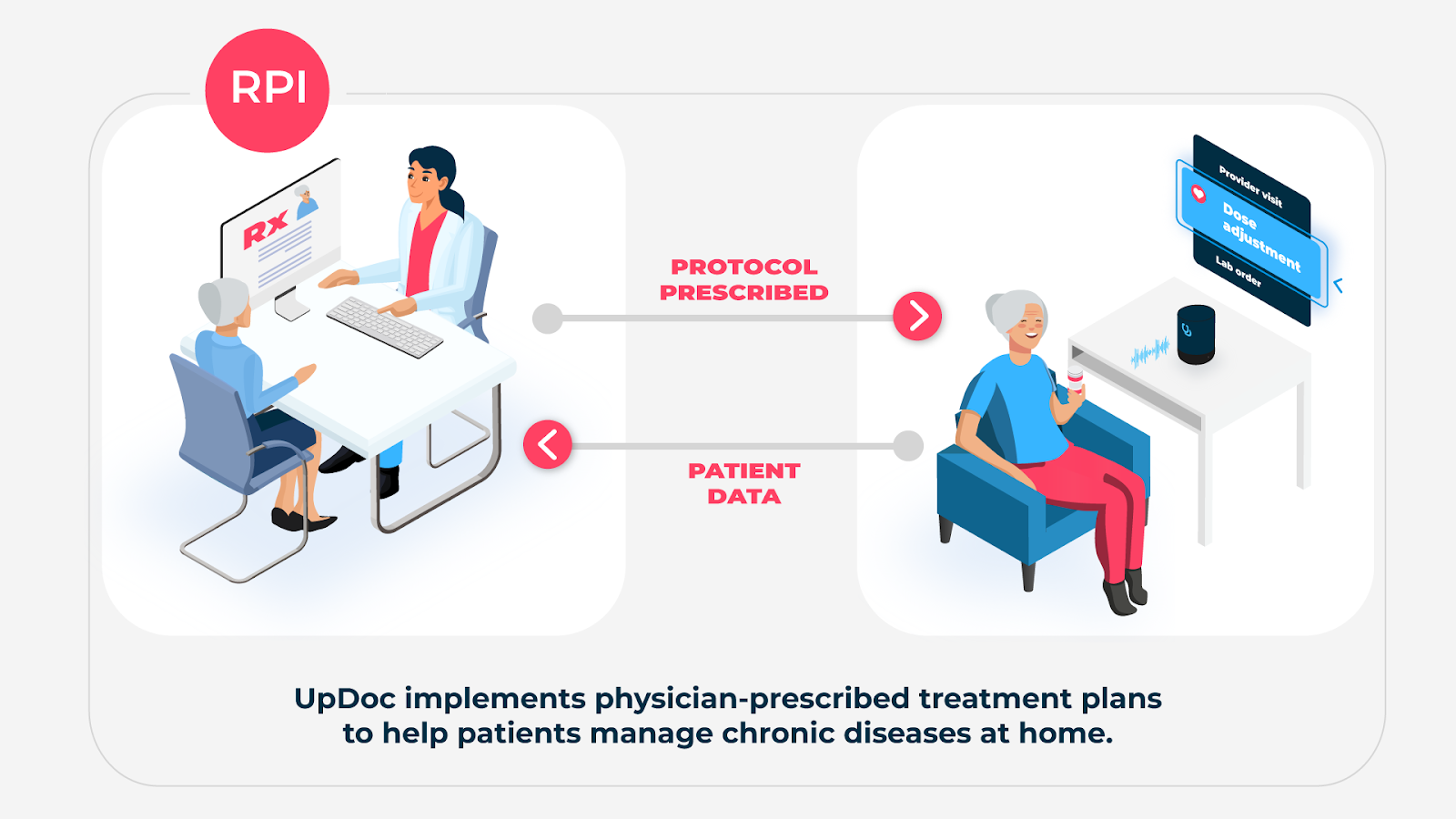
Source- UpDoc
UpDoc’s voice-based AI assistant helps patients with Type 2 diabetes manage insulin dosing from home using smart speaker devices. By analyzing verbal blood sugar updates, it gives real-time, personalized insulin guidance. In a 2023 Stanford trial, it helped 81% of patients achieve target glucose levels, compared to just 25% with standard care.
Key Innovation Details
- Country: USA (Palo Alto, California)
- Inventor / Organization: UpDoc Inc.; Inventors: Sharif Vakili and Ashwin K. Nayak
- Patent Status: US Patent No. 12,251,242 B1 granted March 18, 2025
- Funding: Backed by strategic funding in 2024–25, including investors such as Polaris Partners, Eli Lilly & Company, Mayo Clinic, and others. Platform built with clinical collaborations at Stanford Medicine and UCSF Health.
- Market Deployment: Platform in clinical validation and early deployment phases via partnerships with health systems and physician networks. Marketed as Remote Patient Intervention (RPI) model.
Challenges Solved by the Innovation:
The top 3 problems solved by UpDoc AI voice assistant for insulin dosing are:
- Medication Adherence at Home: Many patients struggle to consistently follow insulin schedules due to confusion or forgetfulness. This AI assistant provides daily, spoken instructions that simplify the process, boosting adherence and outcomes.
- Access to Real-Time Guidance: Traditional care often delays insulin adjustments until the next clinic visit. This system offers instant dose recommendations using verbal glucose inputs, closing the gap between need and action.
- Tech Accessibility for Older Adults: Digital tools can overwhelm elderly users. By using voice interaction via familiar smart speaker devices, the AI lowers the barrier to tech adoption and supports independent disease management.
3. AI-Powered Scan Formatting Tool – GE Healthcare
Source- GE Healthcare
GE HealthCare’s Spine Auto Views leverages deep learning to automate the reformatting of spine CT scans into standardized, anatomically labeled views. The AI system identifies vertebrae and discs with over 90% accuracy and generates perfectly aligned axial, coronal, and sagittal plane images in seconds.
Key Innovation Details
- Country: USA
- Inventor / Organization: GE Precision Healthcare LLC; inventors include Jingyi Yang, Mingyang Yang, Yanran Xu, Yuting Dou, Bipul Das, and Maud Bonnard.
- Patent Status: US Patent No. 12,272,023 B2, officially issued April 8, 2025
- Funding: Internal R&D by GE HealthCare. Their expansion into AI imaging solutions was featured at RSNA and global medical imaging forums.
- Market Deployment: Embedded within GE imaging platforms (e.g., CT/MRI systems) under the Precision DL branding. Also available to hospitals leveraging GE’s AI-based workflow enhancements.
- Regulatory Status: Received FDA 510(k) clearance as a Class II medical device (product codes JAK and QIH) in late 2023.
Challenges Solved by the Innovation:
The AI Spine Auto Views system by GE HealthCare helps overcome these key issues:
- Manual Image Reconstruction: Radiology staff typically spend valuable time reformatting CT slices to view the spine in different planes. This tool eliminates that burden by auto-generating all required views instantly.
- Annotation Fatigue and Inconsistency: Vertebral labeling is tedious and prone to human error. The AI ensures consistent and accurate anatomical labeling across the full spine, improving reporting quality.
- Workflow Bottlenecks in Radiology: Manual steps slow down imaging workflows and increase turnaround time. This automation speeds up diagnosis, allowing faster and more efficient radiology operations.
Also Read: Innovation in Construction: 10+ Breakthroughs Reshaping the Industry in 2025
4. AI-Powered Radiology Reporting Assistant – Northwestern
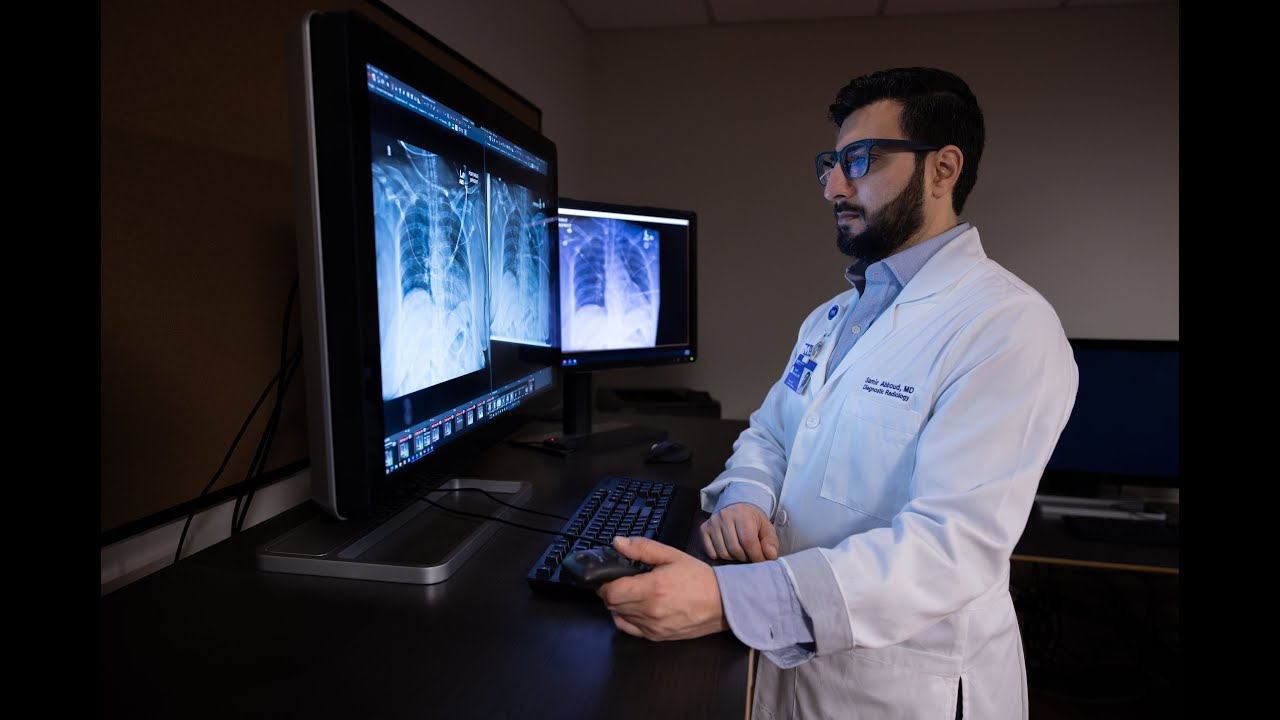
Source- Northwestern Medicine
Northwestern Medicine has developed an in-house generative AI system that drafts radiology reports and flags critical findings in real time. Deployed across 11 hospitals, the AI analyzed 24,000 X-ray exams over five months and generated 95% complete draft reports in the radiologist’s preferred style.
Northwestern Medicine has developed an in-house generative AI system that drafts radiology reports and flags critical findings in real time. Deployed across 11 hospitals, the AI analyzed 24,000 X-ray exams over five months and generated 95% complete draft reports in the radiologist’s preferred style. This significantly boosted efficiency, with some radiologists seeing up to 40% improvement in reporting speed.
Key Innovation Details
- Country: USA
- Organization / Inventors: Northwestern Medicine radiology and informatics team led by Mozziyar Etemadi, MD, PhD, Jonathan Huang, MD, and collaborators.
- Patent Status: Two US patents granted in 2025; additional patents pending across disease detection and reporting features.
- Funding: Developed internally by Northwestern Medicine’s “Bell Labs–style” in‑house engineering team. Funded through institutional research support and clinical innovation grants.
- Market Deployment: Live deployment across Northwestern’s 11 hospitals; over 24,000 generated reports analyzed during a five-month pilot in 2024.
Challenges Solved by the Innovation:
Here are some primary limitations in traditional spine imaging that this innovation resolves:
- Time-Consuming Reporting: Traditional report generation involves manual entry or dictation, which slows down radiologists. The AI automates this by drafting near-complete reports, reducing time spent per case.
- Workflow Inefficiency: Radiologists are often overburdened with high exam volumes. The AI boosts productivity by up to 40% for some users, streamlining workflows across multiple hospitals.
- Variation in reporting styles: The AI adapts to each radiologist’s preferred tone and format, maintaining consistency and personalization.
5. CareSpace – Persivia Inc
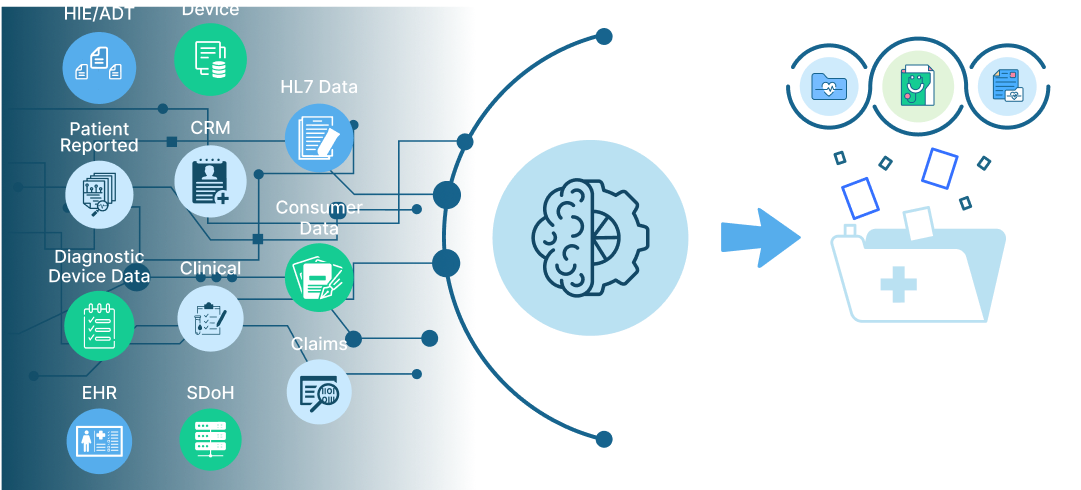
Source- Persivia
CareSpace is an AI-powered digital health platform that enables care teams to manage patients more effectively across the entire care journey. It unifies clinical, claims, and social data into a real-time patient profile to support quicker, data-driven decisions. At its core is Soliton, a patented AI engine that analyzes data continuously, flags urgent issues, and recommends next-best actions instantly.
Key Innovation Details
- Country: USA (Marlborough, Massachusetts)
- Inventor / Organization: Persivia Inc. (development team, Soliton AI engine)
- Patent Status: US Patent No. 12,254,975 B2 granted May 7, 2025
- Funding: Raised $107 million in a strategic growth round led by Aldrich Capital Partners (investments completed in February 2025).
- Market Deployment: Deployed across 200+ hospitals and used by 12,000+ clinicians in the U.S.
- Regulatory Status: NCQA‑certified (HEDIS, DAV), HITRUST-certified; supports HIPAA-compliant workflows.
Challenges Solved by the Innovation:
The Carespace technology tackles these three long-standing challenges:
- Rigid Care Management Tools: Its modular design lets providers customize features, making it adaptable for fee-for-service or value-based care models.
- Siloed Clinical and Non-Clinical Data: Care teams often lack a complete picture of the patient. CareSpace integrates EHR, claims, and social determinants into one actionable profile.
- Reactive, Delayed Interventions: Traditional systems identify issues only after a crisis occurs. Soliton flags risks in real time, enabling proactive, preventive care.
6. AI-Powered CLE Imaging – Mauna Kea Technologies

Source- Mauna Kea Technologies
Mauna Kea’s AI innovation in healthcare enhances confocal laser endomicroscopy (CLE) image sequences in real time to assist doctors with accurate interpretation. It improves the ‘cognitive interface’ between clinician and machine by highlighting key features, filtering noise, and flagging suspicious patterns, like cancerous cells.
Key Innovation Details
- Country: France / USA (Mauna Kea Technologies S.A.)
- Inventor / Organization: Mauna Kea Technologies, inventor of the Cellvizio® probe-based CLE platform
- Patent Status: US Patent (14th AI-related) granted July 21, 2025, covering real-time AI enhancement for CLE imaging. 13th US patent, previously issued in January 2025, for complementary AI workflows in CLE.
- Market Deployment: Integrated into the Cellvizio® pCLE system, used globally at 15+ major endoscopy centers; enables real-time lesion imaging during standard procedures.
- Regulatory Status: The Cellvizio® system holds FDA clearance and CE mark; AI enhancements incorporated under existing regulatory approvals.
Challenges Solved by the Innovation:
The Carespace technology tackles these three long-standing challenges:
- Complex, Noisy Imaging Data: CLE imaging often produces visually dense and noisy video streams that are hard to interpret in real time. The AI filters out irrelevant signals, allowing physicians to focus only on the most diagnostically important features.
- Delayed or Missed Pattern Recognition: Detecting early signs of cancer requires identifying subtle and fleeting patterns in live cellular footage. The system enhances pattern visibility and flags suspicious regions instantly, improving diagnostic accuracy.
- Cognitive Overload During Procedures: Reviewing continuous video of cellular activity demands high concentration and rapid decision-making from doctors. The AI works as a real-time copilot, offering visual cues and guidance to ease the mental burden on clinicians.
Also Read: 8 Best Patent Portfolio Management Software in 2025
7. Smart-Matching Worker Marketplace – StaffDNA
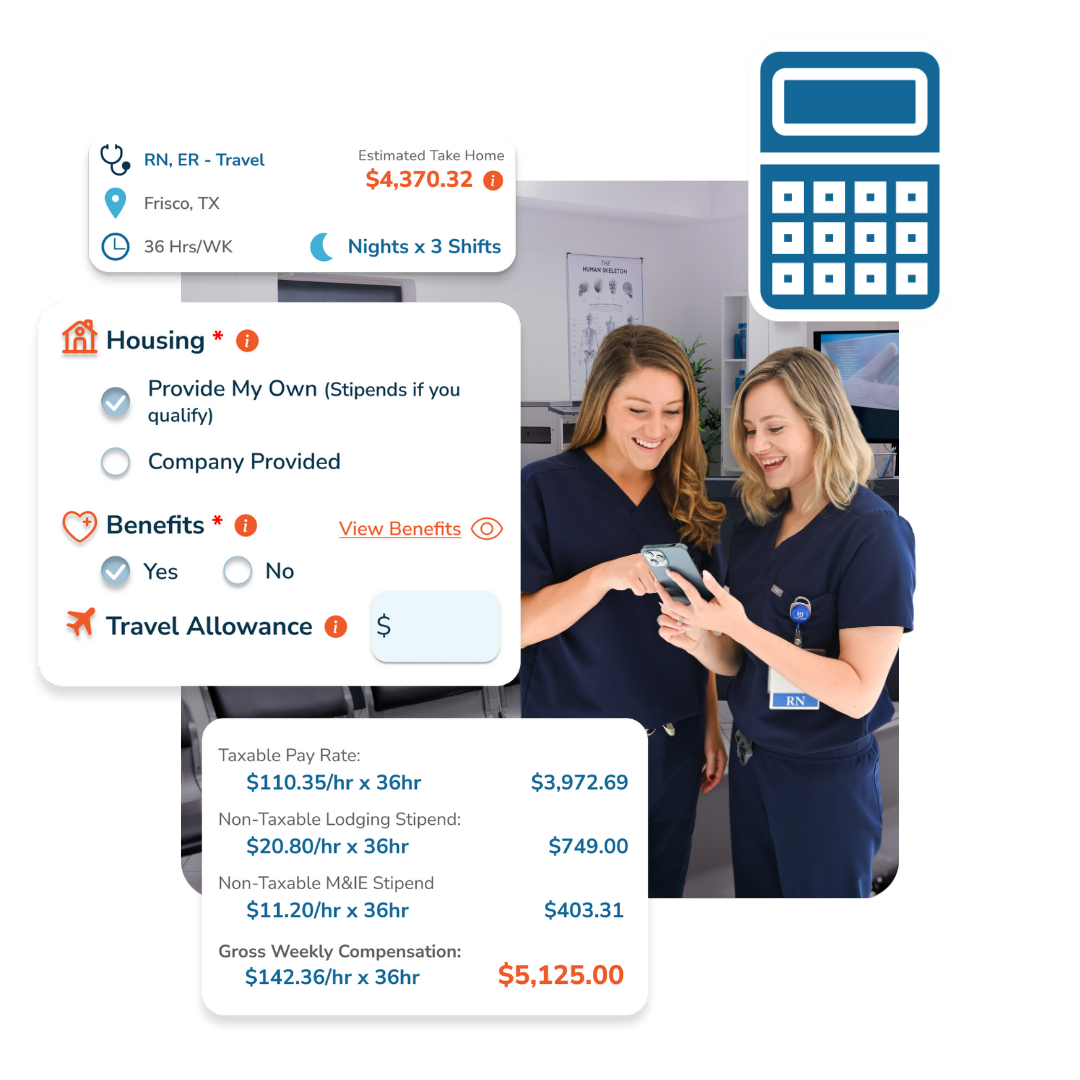
Source- StaffDNA
StaffDNA runs a digital marketplace that matches healthcare professionals with open roles using its AI algorithm, DNai™. The system analyzes a candidate’s skills, certifications, preferences, and real-time market data to recommend the best-fitting job opportunities. This accelerates placement speed and improves satisfaction for both job seekers and healthcare employers.
Key Innovation Details
- Country: USA (Plano, Texas)
- Inventor / Organization: StaffDNA, founded by Sheldon Arora and Jenny Hanlon, Plano, Texas
- Patent Status: Awarded 13 US patents in February 2025, covering candidate and client-facing AI mechanisms in its marketplace platform
- Market Deployment: As of early 2025, StaffDNA connects 1.5M+ healthcare professionals to facilities nationwide through its app.
- Regulatory Status: Operates under standard healthcare employment protocols. Also, the platform is recognized by The Joint Commission for healthcare staffing certification.
- Awards/recognition: The company has received awards such as Fast Company’s World Changing Ideas recognition for upending the traditional staffing model.
Challenges Solved by the Innovation:
With the help of AI, StaffDNA addresses these three fundamental obstacles:
- Manual Job Matching is Slow and Inefficient: Traditional staffing processes often rely on human recruiters to sift through applications and match candidates manually. DNai™ automates this by instantly surfacing jobs tailored to a candidate’s profile.
- Lack of Real-time Labor Market Visibility: Healthcare hiring trends can shift rapidly based on season, region, or specialty demand. Candidates and recruiters often lack up-to-date insights into these changes. DNai™ incorporates real-time hiring data to make smarter, more adaptive job recommendations.
- Candidate Drop-off Due to Poor Experience: Frustrating job search experiences, like irrelevant listings, lengthy processes, or mismatched roles can drive healthcare workers away. DNai™ reduces friction by personalizing the job search, increasing engagement and retention.
8. RCM-Gen EHR Summarizer – Ensemble Health Partners
Ensemble’s GenAI for Clinical Alignment
Ensemble Health Partners developed “RCM-Gen,” a generative AI system with a “Navigator” function that automates claim-related data processing. It scans the EHR to retrieve diagnoses, procedures, and notes, then drafts a claim summary and can even trigger actions like submission or appeal. This tool has enabled intelligent automation of around 25% of transactions in select revenue cycle categories.
Key Innovation Details
- Country: USA
- Organization / Inventor: Ensemble Health Partners (developer of the EIQ® revenue cycle AI platform)
- Patent Status: Granted its 11th US patent on January 13, 2025, specifically covering its AI-driven workflows used in clinical settings and EHRs.
- Funding: Backed by Ensemble’s strategic internal R&D spending (~2M development hours over years). Development was financed through existing reuse and enterprise framework.
- Market Deployment: Active within EHR systems of hospital partners. Patented AI features used to automate summary generation and intelligent actions at scale across health systems partnering with Ensemble.
Challenges Solved by the Innovation:
Ensemble Health RCM- Gen system effectively addresses these three core challenges:
- Manual Claims Processing is Slow and Error-Prone: Billing teams often sift through scattered EHR data to build claims, which is time-intensive and risks missing key information. RCM-Gen automates data retrieval and summarization, improving speed and accuracy.
- High Denial Rates Strain Revenue Cycles: Errors or incomplete information in claims can lead to costly denials and rework. RCM-Gen reduces these issues by generating well-supported summaries and even initiating appeals automatically.
- Staff Burden and Burnout in Revenue Cycle Teams: Administrative staff spend hours on repetitive billing tasks, leading to inefficiencies and burnout. RCM-Gen acts like a virtual assistant, handling routine transactions and freeing up human resources for complex cases.
9. DICOM Auto-Correction AI – Siemens Healthineers
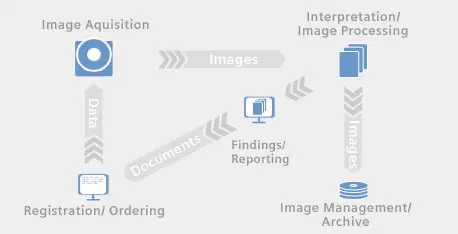
Source- Siemens Healthineers
Siemens has developed an AI-driven tool that detects and corrects metadata errors in DICOM files to improve imaging data quality. It scans incoming studies for mislabeled body parts, patient ID mismatches, or sequence errors and automatically fixes them. This ensures accurate imaging workflows and prevents patient safety risks caused by data inconsistencies.
Key Innovation Details
- Country: Germany (Global operations, U.S. patent granted)
- Inventors: Sailesh Conjeti, Alexis Laugerette, Christian Huemmer
- Patent Status: US Patent No. 12,322,091 B2, issued June 3, 2025
- Market Deployment: Likely integrated into Siemens’ advanced imaging platforms (e.g., syngo.via) or PACS/DICOM systems in hospitals.
Challenges Solved by the Innovation:
Here’s how GE Siemens Auto correction AI tackles three high-impact clinical challenges:
- Frequent Metadata Errors in Imaging Studies: Large hospitals handle thousands of scans daily, and small errors in DICOM tags, like mislabeled anatomy or incorrect patient info can go unnoticed. Siemens’ AI acts as a gatekeeper, catching and correcting errors in real-time.
- Manual DICOM Verification is Time-Consuming and Inconsistent: Traditionally, techs or radiologists must review DICOM metadata manually, which is prone to oversight and drains clinical time. The AI validator automates this step, saving time and improving accuracy.
- Patient Safety Risks Due to Misfiled or Misidentified Scans: If a scan is linked to the wrong patient or body part, it can result in wrong diagnoses or procedures. Siemens’ AI reduces such risks by flagging inconsistencies and cross-referencing data across records before harm occurs.
Also Read: How to Ensure High-Quality Patent Filings — 5 Key Steps for Portfolio Managers
10. Smart Claims Review System – Avalon Healthcare
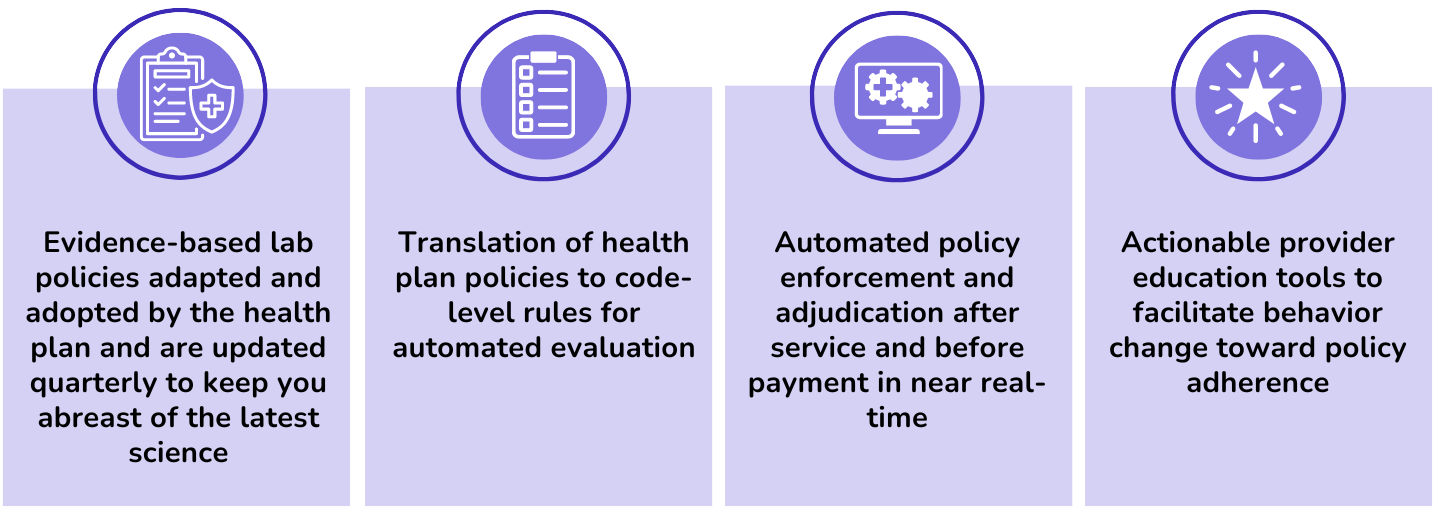
Source- Avalon
Avalon Healthcare Solutions’ APEA (Automated Policy Enforcement Application) is an AI-powered platform that reviews lab test claims in real time. It integrates with health plan systems to instantly verify medical necessity, coverage, and billing accuracy based on clinical policies. APEA also supports lab decision-making at the point of care, helping providers avoid denials and delays.
Key Innovation Details
- Country: USA
- Organization / Inventor: Avalon Healthcare Solutions (Lab Insights company)
- Patent Status: US Patent No. 12,148,534 B1, issued April 16, 2025
- Market Deployment: Deployed across health plan clients covering 40+ million lives. Processing over 18 million claims monthly and providing 1 million+ real-time edits per client nationwide
- Regulatory Status: Operates on a HITRUST‑certified, HIPAA‑compliant platform. The system uses NCQA-certified lab policy frameworks. It functions under standard payer and provider authorization processes.
Challenges Solved by the Innovation:
With the help of AI, Avalon Healthcare’s APEA deals with these critical fundamental issues:
- Lack of Real-Time Clinical Coverage Guidance: Doctors often order tests without knowing if they’ll be covered or reimbursed, leading to surprise denials. APEA gives instant feedback at the point of care, helping make smarter test choices.
- High Administrative Costs and Payer-Provider Friction: Handling documentation requests and claim appeals increases cost and slows care delivery. APEA reduces this friction by automating approvals or flagging claims needing review, saving time for labs, payers, and providers.
- More Denial Rates Due to Inconsistent Lab Test Justification: Many lab test claims are denied because physicians fail to provide documentation that aligns with payer policies. APEA solves this by using AI to match diagnosis and test codes with coverage criteria in real time.
What’s Next in AI-Driven Care?
As we’ve seen in this article, AI innovation in healthcare is a patent-backed reality shaping the future of patient care. But behind every one of these breakthroughs lies a critical process: capturing, managing, and protecting intellectual property effectively.
That’s where the TIP Tool™ by Triangle IP comes in. Designed for inventors, R&D teams, and IP professionals, the TIP Tool™ transforms how you manage your innovation pipeline with:
- Idea capture: Easily collect innovation disclosures from engineers and researchers with a sleek, no-login form that’s built for adoption.
- Real-time collaboration: Bring legal, business, and technical teams together to evaluate ideas and make faster decisions.
- Patent pipeline visibility: Visualize where each idea stands, from capture to patent grant, so nothing gets overlooked.
- Case analytics & cost estimation: Use historical data to predict the likelihood of patent grants and associated costs.
- Patent counsel & examiner statistics: Make smarter filing decisions by analyzing attorney and examiner performance.
- Automatic USPTO updates: Stay on top of application statuses without logging into multiple tools.
- Intuitive dashboards: Track ROI, costs, and innovation trends, all in one place.
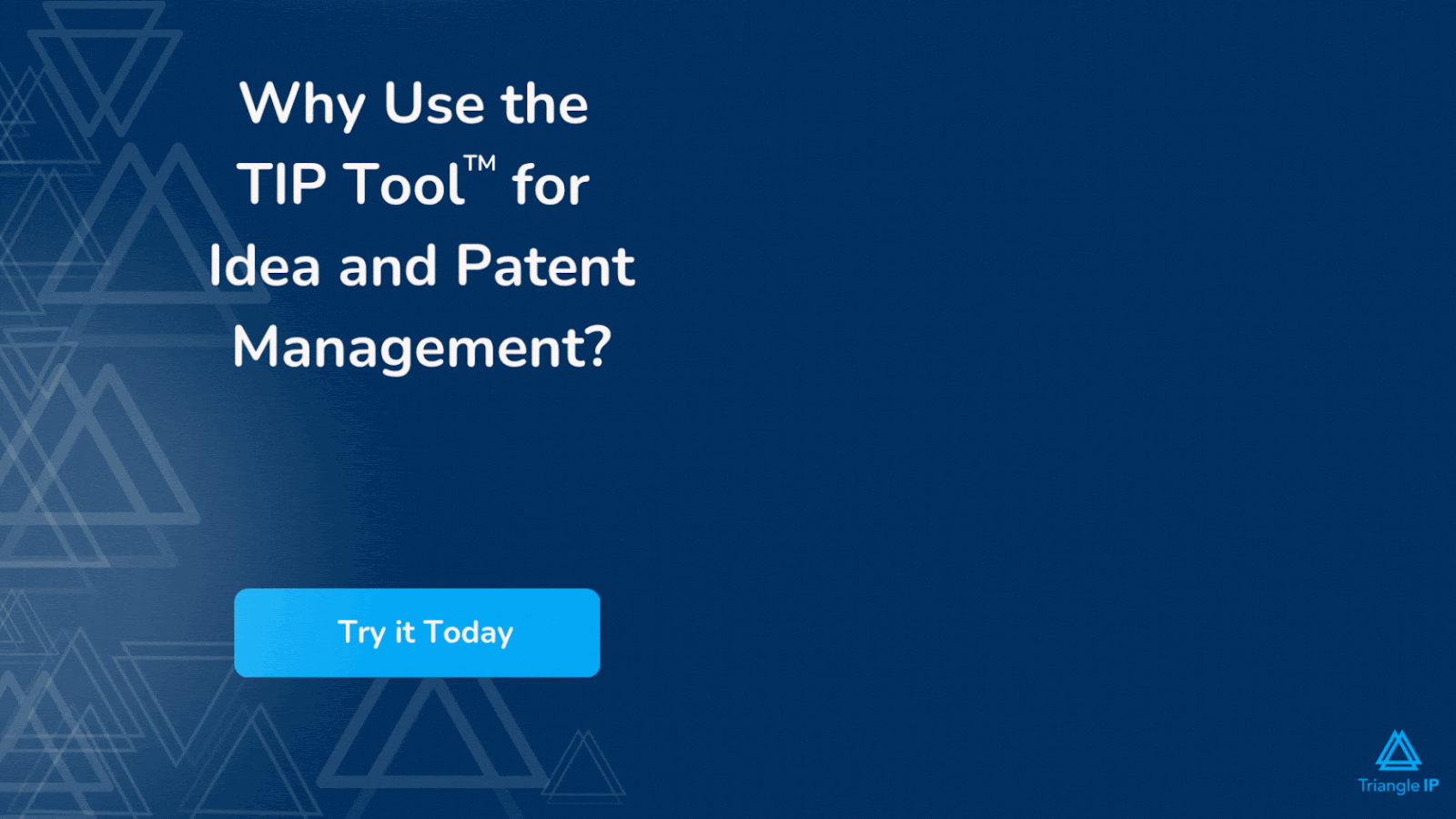
Explore the TIP Tool™ today and turn your next great idea into a strategic, protected asset.
Disclaimer: The information provided here is for informational purposes only and reflects publicly available details as of the date of publication. For the latest updates on innovations, please consult the respective organizations.
FAQs
1. What is the Future of AI in Healthcare?
AI is set to revolutionize healthcare with predictive diagnostics, personalized treatment, and real-time clinical decision support. It will reduce costs, improve outcomes, and make care more accessible globally.
2. When was AI First Used in Healthcare?
AI was first used in healthcare in the 1970s. Early systems like MYCIN, developed at Stanford, helped diagnose bacterial infections and recommend antibiotics.
3. What is the Primary Application of Generative AI in Healthcare?
Generative AI is used for automating clinical documentation, generating medical reports, and enhancing patient communication through chatbots and personalized summaries.
4. What are the Three AI Categories in Healthcare?
The main AI categories are:
- Descriptive AI (e.g. data analysis and visualization),
- Predictive AI (e.g. risk scoring, diagnosis),
- Prescriptive AI (e.g. recommending treatments or workflows).
